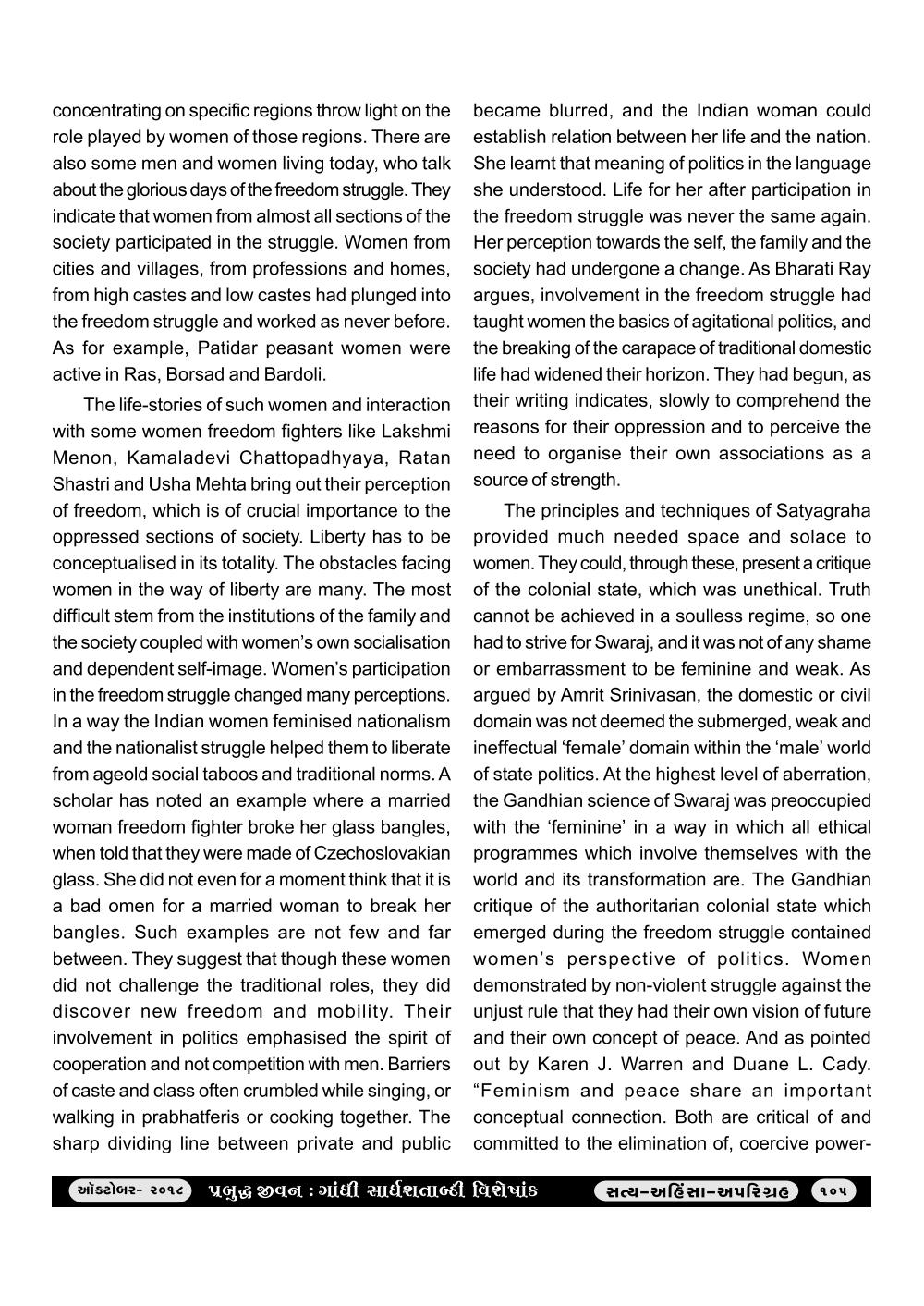________________
concentrating on specific regions throw light on the became blurred, and the Indian woman could role played by women of those regions. There are establish relation between her life and the nation. also some men and women living today, who talk She learnt that meaning of politics in the language about the glorious days of the freedom struggle. They she understood. Life for her after participation in indicate that women from almost all sections of the the freedom struggle was never the same again. society participated in the struggle. Women from Her perception towards the self, the family and the cities and villages, from professions and homes, society had undergone a change. As Bharati Ray from high castes and low castes had plunged into argues, involvement in the freedom struggle had the freedom struggle and worked as never before. taught women the basics of agitational politics, and As for example, Patidar peasant women were the breaking of the carapace of traditional domestic active in Ras, Borsad and Bardoli.
life had widened their horizon. They had begun, as The life-stories of such women and interaction their writing indicates, slowly to comprehend the with some women freedom fighters like Lakshmi reasons for their oppression and to perceive the Menon, Kamaladevi Chattopadhyaya, Ratan need to organise their own associations as a Shastri and Usha Mehta bring out their perception source of strength. of freedom, which is of crucial importance to the The principles and techniques of Satyagraha oppressed sections of society. Liberty has to be provided much needed space and solace to conceptualised in its totality. The obstacles facing women. They could, through these, present a critique women in the way of liberty are many. The most of the colonial state, which was unethical. Truth difficult stem from the institutions of the family and cannot be achieved in a soulless regime, so one the society coupled with women's own socialisation had to strive for Swaraj, and it was not of any shame and dependent self-image. Women's participation or embarrassment to be feminine and weak. As in the freedom struggle changed many perceptions. argued by Amrit Srinivasan, the domestic or civil In a way the Indian women feminised nationalism domain was not deemed the submerged, weak and and the nationalist struggle helped them to liberate ineffectual 'female' domain within the 'male' world from ageold social taboos and traditional norms. A of state politics. At the highest level of aberration, scholar has noted an example where a married the Gandhian science of Swaraj was preoccupied woman freedom fighter broke her glass bangles, with the 'feminine' in a way in which all ethical when told that they were made of Czechoslovakian programmes which involve themselves with the glass. She did not even for a moment think that it is world and its transformation are. The Gandhian a bad omen for a married woman to break her critique of the authoritarian colonial state which bangles. Such examples are not few and far emerged during the freedom struggle contained between. They suggest that though these women women's perspective of politics. Women did not challenge the traditional roles, they did demonstrated by non-violent struggle against the discover new freedom and mobility. Their unjust rule that they had their own vision of future involvement in politics emphasised the spirit of and their own concept of peace. And as pointed cooperation and not competition with men. Barriers out by Karen J. Warren and Duane L. Cady. of caste and class often crumbled while singing, or "Feminism and peace share an important walking in prabhatferis or cooking together. The conceptual connection. Both are critical of and sharp dividing line between private and public committed to the elimination of, coercive power
ઑક્ટોબર- ૨૦૧૮) પ્રબદ્ધ જીવન : ગાંધી સાર્ધ શતાબ્દી વિશેષાંક
(સત્ય-અહિંસા- અપરિગ્રહ) (૧૦૫




